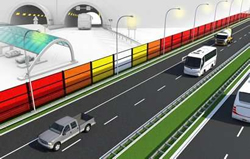Start of test with solar energy generating noise barriers alongside highway
 Alongside the A2 highway near Den Bosch, The Netherlands, two test noise barriers are installed that generate solar energy. The aim of this practical test, that was officially launched 18 June is to assess the economic and technical feasibility of this form of energy generating noise barriers. Playing a key role in the test are the LSC panels, developed by researcher Michael Debije at TU/e.
Alongside the A2 highway near Den Bosch, The Netherlands, two test noise barriers are installed that generate solar energy. The aim of this practical test, that was officially launched 18 June is to assess the economic and technical feasibility of this form of energy generating noise barriers. Playing a key role in the test are the LSC panels, developed by researcher Michael Debije at TU/e.
The translucent, colored panels are a new type of energy source, developed jointly by TU/e. These 'luminescent solar concentrators' (LSCs) receive sun light and guide it to the side of the panels. There, it lands in concentrated form on traditional solar cells. "Thanks to their many colors the LSC are visually very attractive, which makes them ideal for use in many different situations in the built environment", explains Debije of the Department of Chemical Engineering and Chemistry, who has carried out years of research into these panels. "Further benefits are that the principle used is low cost, they can be produced in any desired, regular color, is robust, and the LSCs will even work when the sky is cloudy. That means it offers tremendous potential." Debije published his latest research findings on this subject last March in Nature.
On 18 June a one-year practical test started in 's-Hertogenbosch, led by the building company Heijmans. The researchers intend to assess the feasibility of generating electricity using solar cells integrated in noise barriers or SONOBs (Solar Noise Barriers). Cont'd...
Comments (0)
This post does not have any comments. Be the first to leave a comment below.
